
The minibus picked us up from the hotel at 9:15 and off we went to the harbor at Albufeira. The condos by the harbor were a bright complement to the sparkling sky and sea.

This was our 20' sailboat, the Amorita. There were about 17 people onboard, couples and a few families. Although there was no sightseeing "audio" a la "on your left are the magnificent...." we were regaled with Portuguese pop music. It was bright and happy music--Portuguese equivalent of Las Vegas chanteurs and chanteuses. Spoken Portuguese is difficult for me to understand. I can understand a great deal of French and some Spanish and, actually, I can recognize some written Portuguese words. But the Portuguese pronunciation was something I just couldn't recognize. Wikip
edia says it is similar to French; I didn't find it so. Still, melodies are melodies and I thoroughly enjoyed relaxing on the boat deck as we plowed through the waves listening to what I was sure, by the melody and yearning in the singer's voices, were Portuguese love songs.


As the boat chugged along the coast using its motor rather than the sails--I think that the wind wasn't strong enough for us to move along fast enough by sail power alone but I don't know why they didn't put the sails up--I was mesmerized by the cliffs and rock formations.


That one reminded me of photos I have seen of carvings along the Nile. No human hand had carved these formations though.
We passed many small beaches, some with bathers, some deserted. Some I only glimpsed through the rock formations.



The boat cruised along for about 2 hours and then we dropped anchor just off a beautiful beach. The sailors took some large bags in the dinghy over to the beach to set up the bbq. Then one came back and took us in two small groups, first into a nearby cavern to see the rock formations and then over to the beach where we jumped into the ankle-deep water and waded ashore.


We sunbathed and swam while we were waiting for the bbq. The water was cool, the sand was hot. I slathered on the suntan lotion, determined not to get a sunburn and, at the end of the day, was quite pleased that I had succeeded. I wasn't getting super brown but I also wasn't becoming a tomato.


The bbq was delicious. Grilled chicken, pork and Portuguese sardines, tomato salad, and crusty bread. They offered us as much as we could eat. I had never eaten fresh sardines before; they tasted a bit like trout but saltier. And quite yummy.
After we finished we had another hour of sunbathing until the tide started to come in, lapping at our feet and towels. There was a Finnish family nearby us, the young daughter beachcombing and finding pretty shells. Although she spoke no English, we managed to communicate our mutual interest in shells and we traded a couple back and forth. Then we saw that our sailors were packing things up so we gathered our beach towels and stuff and lined up for the dinghy ride back to the boat.



It was difficult to climb in and out of the dinghy elegantly, especially on the beach. But we didn't lose anyone and that's the main thing.
I took more photos of the rock formations along the coast as we headed. So amazing. And what a wonderful day!! We arrived back at the marina at about 4:30, were collected by the minibus and were back at our resort by 5:00 p.m. We showered off the salt water, had a light dinner and then went to karaoke night. Yes, I sang and yes, Sheila filmed me with her camera. And no, a copy of that is NOT going to appear in my blog!














































